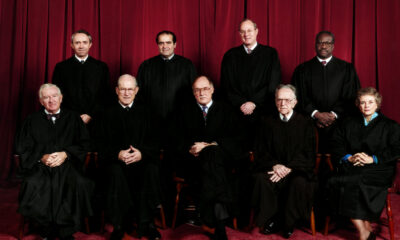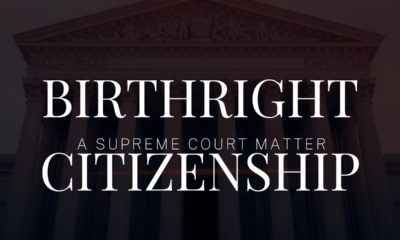Judicial
Election case at argument
Moore v. Harper, the election law case, came to oral argument. Tim Moore’s lawyer did not present a winning case, as he could have.
Election law, as applicable to elections of Representatives in Congress, came before the United States Supreme Court yesterday. The Court heard argument on this one case for almost three hours. Today CNAV concludes that lawyers for the North Carolina House of Representatives did not prepare adequately to argue for the sweeping change in election law they sought. Which was to cut the courts of North Carolina out of the process of drawing Congressional district maps. Furthermore the only reason we are at this pass is a set of precedents that make a mockery of federalism. Counsel for petitioners could and should have challenged that entire framework. They did not, and for that reason they will likely lose.
What this election law case is about
The case at issue is Moore v. Harper (Docket no. 21-1271). Reportage on the argument session comes from CBS News and Politico, with a “live blog” from Democracy Docket. In addition, readers can play the MP3 recording of the session directly, or read the transcript.
The case is a petition for review of a decision by the North Carolina Supreme Court. After the 2020 Census, North Carolina’s Republican dominated legislature drew a map favorable to their party. Several plaintiffs, including Common Cause, challenged the map as an unlawful partisan gerrymander. The North Carolina Supreme Court, applying North Carolina law, agreed and has struck down the maps. So Rep. Tim Moore (R-Cleveland and Rutherford Cos.), Speaker of the North Carolina House, petitioned the Supreme Court for review. In fact, yesterday afternoon Moore tweeted his reasoning for asking for the review:
The “activist judges” accusation comes from the definitely “woke” politics the North Carolina Supreme Court has shown thus far. In fact, furious North Carolina voters flipped the court when two Democrats failed of re-election last Midterms. One of them was Justice Samuel J. Ervin IV. (Yes, he’s one of those Ervins; his grandfather was the witty Chairman of the Senate Watergate Committee.)
How did you expect to liberate Cuba by perpetrating a burglary in Washington, D.C.? Senator Samuel J. Ervin, Jr. (D-N.C.) Chairman, Senate Select Committee on Presidential Campaign Activities
But that won’t help the Republicans press their advantage in redistricting. Tim Moore filed this petition as a Hail Mary pass.
The basis of the petition: the Independent State Legislature theory
Tim Moore filed his petition invoking the Independent State Legislature Theory. According to it, the Constitution vests in State legislatures only the power to draw Congressional districts. (This also includes the power to set laws qualifying voters for Representatives and Senators.) CNAV discussed this before, last July. Briefly, the Constitution says the “legislatures” will prescribe “the time, place and manner of holding elections for Senators and Representatives.” Legislatures, it says – and not the courts.
The Constitution said nothing about a legislature “prescribing by law.” But the Supreme Court held in 1932 that redistricting is a lawmaking function. Therefore, at minimum, State governors have their usual veto powers, as on other bills. (Smiley v. Holm, 285 U.S. 355 (1932)). That holding speaks directly to what a legislature is, and what powers a governor has over the legislative process. It does not, however, explicitly provide for State judicial review of a district map.
More recently the Supreme Court has held that whenever a State Constitution vests redistricting power in an “independent commission,” such commission is a “legislature” within the meaning of the U.S. Constitution. Therefore the federal Constitution cannot override this. (Arizona State Legislature v. Arizona Independent Redistricting Commission, 2015).
This case concerns a legislature within the usual meaning. The governor did not veto the original maps, so Tim Moore decided not to make an issue of veto power. But as a further complication, SCOTUS has already said it will never again hear a partisan gerrymander case. (Rucho v. Common Cause, 2019.)
How do you measure partisan gerrymandering?
In an article in University of Chicago Law Review, Nicholas Stephanopoulos and Eric McGhee proposed a measure they called the efficiency gap to measure partisan gerrymandering. Efficiency in this context means not only winning, but winning with as few votes as a Party needs. Typically this applies only to a two-Party election in a single-member district. The losing party loses all votes cast for it. Contrariwise, the winning party exceeds necessary votes when it wins by more than fifty percent plus one. Any Party wastes votes that they either lose or by which they exceed the Magic Number.
The efficiency gap is the sum of differences (as absolute values)between lost votes (the loser) and excess votes (the winner) over all districts in a State, as a fraction of all votes cast. In mathematical symbols this works out to:
(Σ
| Lost votes by loser – excess votes by winner | / Total vote) * 100%
(Source: Ballotpedia.)
The highest possible efficiency gap is fifty percent. The winner takes all seats by fifty percent plus one, and the loser wastes every vote cast for it. In theory one could achieve balanced efficiency, meaning winners exceed their necessary votes by the same amount that losers waste. That requires winners to take their seats by an average of 75 percent. Winner wastes 25 percent; loser wastes 25 percent; thus they’re even. (And if a Party carries every district with 100 percent of the vote, the efficiency gap is 50 percent.)
What kind of election is this?
Readers will see at once the fundamental flaw in efficiency-gap thinking. The only way to minimize the efficiency gap is to create “safe districts” everywhere. Furthermore, the ideal ratio of voters in any district is three to one for the winner. So the Parties might as well nominate only in their “safe” districts, and no districts will ever be competitive.
Districts will then take on even odder shapes than ever. As they did in order to carve out “safe minority districts” that followed Interstate Highways or railroad tracks.
The legislature might as well elect all Representatives at-large by proportional representation, as they do in Israel. The State holds an election, and determines a total popular vote distribution between Parties. Then the Secretary of State awards mandates, or slots, to each Party in proportion to that popular vote. Where, then, is the accountability that democratic elections are supposed to provide?
Better to make certain rules for legislative or Congressional redistricting. How about forbidding a District boundary to cross a county line, city or town limit, or city ward line? How about not splitting a county or independent city unless each District in the split is par of that county or independent city?Ideally, each county or independent city should get one or two State Senators. But apparently the Supreme Court has said no to that, also.
“One person, one vote” is an unhealthy obsession. Tim Moore could and should have challenged that. Sadly, he did not.
How the argument went
Instead, Moore (or rather David Thompson, his attorney) tried to argue that although governors have a role, courts do not. In this he drew inspiration from Chief Justice William Rehnquist’s concurrence in Bush v. Gore (531 U.S. 98, 113 (2000)). That case involved Presidential Electors, another question the Constitution gives to legislatures to answer. Rehnquist wrote (and Justices Antonin Scalia and Clarence Thomas agreed with him) that:
A significant departure from the legislative scheme for appointing Presidential electors presents a federal constitutional question.
As seems to be his pattern, Justice Thomas opened by asking Mr. Thompson to state clearly the Court’s jurisdiction in the case. Naturally Mr. Thompson cited the Elections Clause of the Constitution.
Soon afterward – and this did not change throughout the argument session – three blocs of Justices sorted themselves out. Justices Ketanji Brown Jackson, Elena Kagan, and Sonia Sotomayor were uniformly hostile to the petitioner and sympathetic to the respondents. (And to Solicitor General Elizabeth Prelugar, arguing as friend of the court.) Justices Thomas, Samuel A. Alito, and Neil Gorsuch likewise proved sympathetic to the petitioners.
The bloc of Chief Justice John Roberts and Justices Amy Coney Barrett and Brett Kavanaugh became the “Neutral Bloc.” All three members of it asked the hardest questions of petitioners and respondent side alike.
Weaknesses of the opposing election cases
Tim Moore should have known over how high a bar he was trying to vault. As the Liberal and Neutral Blocs made abundantly clear, he is trying to override 233 years of history. The Independent State Legislature Theory finds some support in Bush v. Gore, but in a concurrence only, not the opinion of the Court. Of the three concurring Justices, only Clarence Thomas remains – though Alito and Gorsuch do seem to sympathize with him.
On the other hand, the two lawyers for the respondents – and the Solicitor General – seemed to be trying to present a case of res ipsa loquitur. (That’s Latin for “The thing speaks for itself.”) They also said that “chaos” would reign if the Court finds for Moore. The only practical result of this “chaos” they could allege is that State legislatures could draw districts however they wanted. What they really mean is that they (petitioners and the Solicitor General) would lose all the ground they have carefully gained toward their true goal: proportional representation, by color, race, creed, lifestyle, etc.
The Justices seem to know this. Chief Justice Roberts trapped Thompson into expressing willingness to accept a rule limiting the efficiency gap to seven percent. But in so doing, Roberts exposed the most glaring weakness in the respondents’ case: no firm rules exist. The North Carolina Supreme Court simply made their determination and had no firm theory to back that up.
How did we get here?
The Supreme Court is hearing this momentous election case because Brett Kavanaugh looked at the prior election jurisprudence and quailed. “This is going to crop up again and again until we finally settle it!” he said in effect. “Enough! Let’s ‘grant cert’ in this or a similar case, set a precedent, and have done with this!” So we can guess which four Justices (at least) voted to grant review in Moore v. Harper: Thomas, Alito, Gorsuch, and Kavanaugh.
And when he briefed the Court, Moore’s lawyer made key mistakes. He could and should have seized upon the absence of the key phrase by law in the Elections Clause and the Presidential Electors Clause. Justice Alito has already said (Dobbs v. Jackson Women’s) that stare decisis is not a hard-and-fast principle anymore. So if cases like Smiley or Arizona needed re-litigating, then by all means re-litigate them! Had Thomas Dobbs made a similar error, he would not have achieved the result we all know. But the Mississippi Solicitor General boldly decided to re-litigate Roe v. Wade, and won the grand prize.
But many other precedents need re-litigating. All the litigation on gerrymandering have assumed that:
- Political parties are legitimate, and
- Proportional representation between and among them is only fair.
Both are wrong, and both needed challenge. This case is a missed opportunity. And though the Neutral Bloc asked equally hard questions of both sides, in the end they will find for the respondents.
Terry A. Hurlbut has been a student of politics, philosophy, and science for more than 35 years. He is a graduate of Yale College and has served as a physician-level laboratory administrator in a 250-bed community hospital. He also is a serious student of the Bible, is conversant in its two primary original languages, and has followed the creation-science movement closely since 1993.
-

 Executive4 days ago
Executive4 days agoThe Last Supper: New York’s Socialist Feast
-

 Civilization4 days ago
Civilization4 days agoYoo Hoo, VP Vance—Your Character is Showing!
-

 Civilization18 hours ago
Civilization18 hours agoDC Pipe Bomb Arrest Raises Questions About Christopher’s Wray’s FBI
-

 Civilization5 days ago
Civilization5 days agoIvory Tower Thinking and Narcotics Boats
-

 Guest Columns3 days ago
Guest Columns3 days agoCongressional Leaders See Far Higher Stock Returns Than Peers
-

 Civilization4 days ago
Civilization4 days agoFacing Facts & Rolling Back Mythologies: The New National Security Strategy
-

 Civilization2 days ago
Civilization2 days agoThe Legal Logic Behind U.S. Operations Against Narco-Terrorist Networks
-

 Civilization3 days ago
Civilization3 days agoHow Trump Changed America










